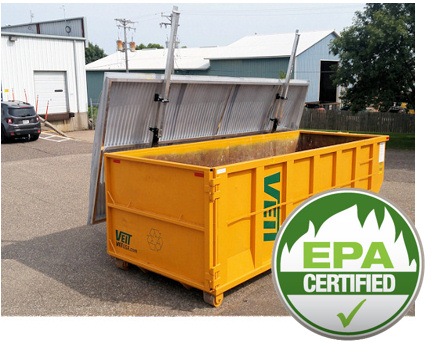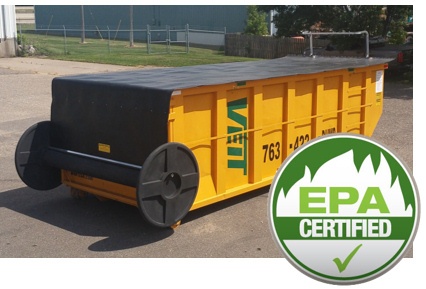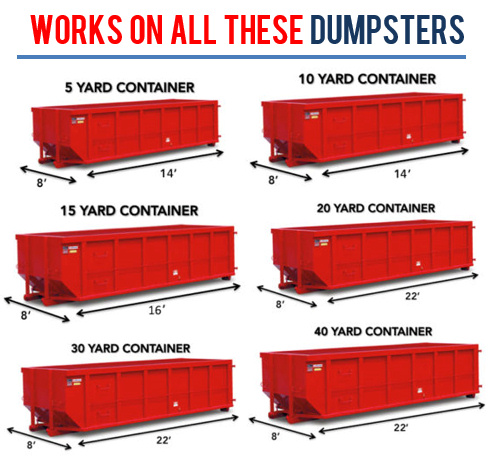
New EPA Rules
The EPA revealed stricter rules for Construction General Permit in February 2017, these rules affect businesses who make use of waste containers on their place of business. A few days later, precisely 16 February 2017, this rules took effect and described how containers must be a shield from rainfall that may lead to stormwater pollution. This rules automatically replaces the 2012 CGP.

The EPA Rules Protect The Enviroment
The new 2017 CGP contains rules like all waste container lids must be closed especially when not in use and always at the end of each business day. Also business should make provision of covers for containers that have no lids or find a similar means of containing the discharge of pollutants. The major reason why this rule was instituted was due to the ever-present fight against pollution through stormwater runoff. Companies and businesses found not abiding by this new rules are liable for facing harsh fines. Fines attached for not following stormwater permit requirements ranges from $2,500 to $25,000 per day.

Storm Water Runoff
There are six activities that can lead to water runoff and pollution troubles, Identified by the EPA. One of this activities is Waste Management. If not all, major industries use waste management as part of their working process, it is important for companies to play their role in reducing stormwater runoff. The new EPA guide or rules for industrial operators on developing a stormwater pollution plan, if waste materials can contaminate stormwater, it must be stored in a confined container or controlled not to mix with stormwater.
Protection From The Elements

Rain Protection

Wind Protection

Snow Protection
Storm water runoff can cause damage to the environment; rain water or water from snow melt that could not go into the ground flows over the ground picking industrial pollutants from different areas like parking lots, empty or incomplete building, roads etc. this contaminated water flows towards a local water sources such as rivers, creeks, lakes or into a sewer system.
Federal guidelines are responsible to dictate how dumpsters or waste containers must be covered. Aside from federal rules, businesses face additional regulations from state and local levels of government. Stormwater contains elements like phosphorus, grease, nitrogen and other chemicals. The EPA expects every company to develop and regulate SWPPPs (Storm Water Pollution Prevention Plan), doing this gives such company an edge to comply with NPDES industrial stormwater permits given by states or the EPA.
“When it comes to SWPPPs, uncovered waste containers are the most common compliance challenges that affect operators,” says the EPA. Leakages are caused if containers are not covered or sealed properly, in other to prevent leakages or control stormwater runoff the waste container has to be properly contained.

Fits All Major Dumpster Sizes
- Fits 5, 10, 15, 20, 30, and 40 yard dumpsters
- Tarp extended length is 26'
- Custom sizes are also available to fit any container
Meeting Compliance With EPA Dumpster Covers
Challenge Alleviation
Roll-off dumpster covers can resolve most of the challenges facing municipalities recycling, manufacturing, industries, and construction sites that always make use of waste containers. This covers offer a simple but effective permanent solution to controlling seepage into the ground thereby protecting companies and businesses from fines. Also, they prevent snow or rainwater and other unwanted materials or pollutants from gaining access to the dumpster. Although the roll-off dumpster may be a standard operating procedure, prior to the new CGP guidelines there was little or no enforcement of existing regulations. Now that the new regulation has been issued and stricter, the need for an effective cover is important.
Most companies, instead of using a proper waste container, use a roll-off tarp to cover their dumpsters. This alternative solution they use is inefficient and prone to sag, leak or tear. During winter or cold months, these tarps are liable to freeze making it heavy and difficult to work with them, also it is very difficult for tarps to hold up during a heavy downpour. Definitely, this will cause noncompliance with the new CGP rules by the EPA. The Roll-off dumpster panel is made with 90% recycled high molecular weight polyethylene and 100% recyclable. Roll-off can be fastened to hooks present in a dumpster to tighten and keep waste materials contained. One of the features of the roll-off is that it is designed to accommodate bowing that may occur at the middle of dumpsters. It needs no special need for modification and no hardware to install.
Keeps Businesses Fees and Fines Free
In carrying out its function the Roll-off dumpster has helped businesses immensely to obtain No Exposure Certification For Exclusion from NPDES (National Pollutant Discharge Elimination System) Storm Water Permit, also SWPPP Certification and ISO14001. The compliance to be in other with stormwater regulations has brought concerns to those in the industry leading to the increase rate of needing to cover an open-air dumpster or face the impending increase on the crackdown of stormwater Run-off regulations. With this cover your business is free from fines this also means you are in compliance with EPA rules.
Unlike other businesses who will always tip officials who come for inspections on their site, businesses with our Roll-off dumpster are free from such tips. Dumpsters with ice or soaked with water are heavier and will cost more to dispose at the landfill due to its weight. Prevent those who ransacks dumpsters looking for recyclables to take, it also minimizes the ability that may arise from illegal discarding or dumpster divers, this issues may indirectly cause noncompliance to the new CGP regulation.
The usage of roll-off is not only cost effective but helps the company remain in a good environment, in compliance with all levels of the government, and reduces cost related to disposal and liability issues. Call in now and save your business from unnecessary fines from the government.
